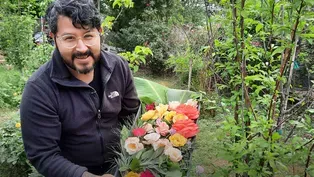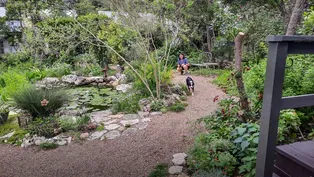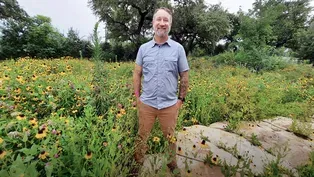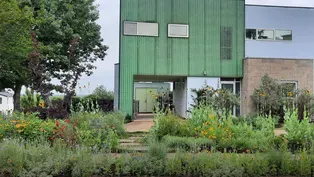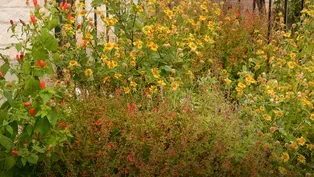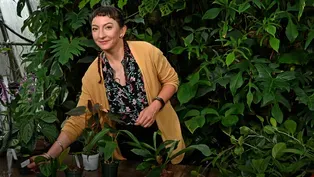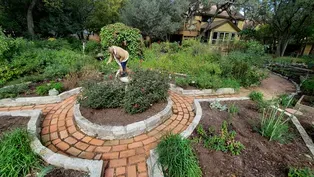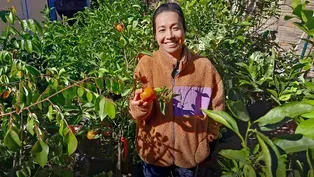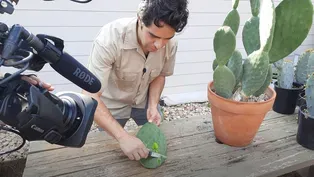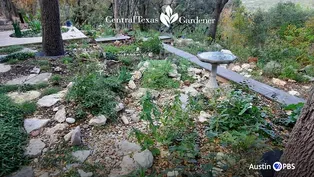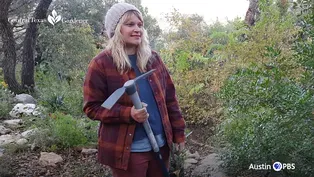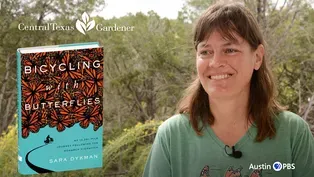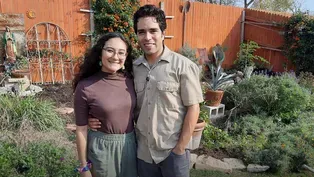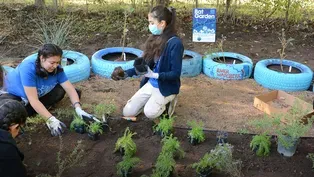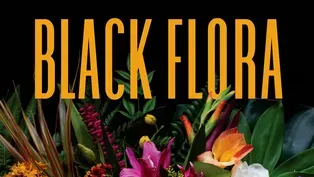
Native Plant Garden from Scratch in HOA: Kathleen Scott
Clip: Season 27 | 8m 33sVideo has Closed Captions
Deer and HOA rules didn’t stop Kathleen and Denny Scott’s wildlife habitat vision.
Kathleen and Denny Scott’s new house came with deer and HOA rules for a percentage of lawn. To plant habitat for pollinators, hummingbirds and song birds, they ringed the yard with native trees and plants, including host plants for butterflies. In the unfenced front yard, they chose plants that resist browsing deer (mostly!).
Problems with Closed Captions? Closed Captioning Feedback
Problems with Closed Captions? Closed Captioning Feedback
Central Texas Gardener is a local public television program presented by Austin PBS
Support for CTG is provided by: Lisa & Desi Rhoden, and Diane Land & Steve Adler. Central Texas Gardener is produced by Austin PBS, KLRU-TV and distributed by NETA.

Native Plant Garden from Scratch in HOA: Kathleen Scott
Clip: Season 27 | 8m 33sVideo has Closed Captions
Kathleen and Denny Scott’s new house came with deer and HOA rules for a percentage of lawn. To plant habitat for pollinators, hummingbirds and song birds, they ringed the yard with native trees and plants, including host plants for butterflies. In the unfenced front yard, they chose plants that resist browsing deer (mostly!).
Problems with Closed Captions? Closed Captioning Feedback
How to Watch Central Texas Gardener
Central Texas Gardener is available to stream on pbs.org and the free PBS App, available on iPhone, Apple TV, Android TV, Android smartphones, Amazon Fire TV, Amazon Fire Tablet, Roku, Samsung Smart TV, and Vizio.
Providing Support for PBS.org
Learn Moreabout PBS online sponsorshipI think planting habitat is so important because in today's world there isn't as much habitat.
And if we want butterflies and bees and hummingbirds and birds, we have to give them a place to breathe and a place to eat and a place to shelter.
[cheerful music] Hi, I'm Kathleen Scott, and my husband and I started this garden from scratch.
There was nothing but Bermuda grass.
I needed to live by HOA requirements which are very stringent for lawns where I live, 75% front yard, 50% back yard.
Therefore, what I did was I ringed my house with beds and I ringed the outside of the yard in a horseshoe from the front with the beds.
And the first thing we did was take up the Bermuda grass.
This sod was new enough that we could rip it up in sections.
And so we ripped it all up and then we sprayed some nutrients on it, put compost on it, covered it with cardboard everywhere.
And then we put mulch over that.
In October of 2021 we could begin to plant and we were planting a lot of four-inch plants because it took pickax to dig in the soil.
The native soil here was limestone, and then because there had been the cedar forest, there was actual real clay soil, but it was soil over it.
Unfortunately, all of that was scraped away.
Red clay was brought in from someplace else, and they were streaks of builders caliche, which was laid down so that they could drive their machines on it.
All of that hard summer was really hard on new plants because they're putting their feet into clay and caliche.
But native plants, oh man, you plant them, right?
And they will grow by themselves pretty much.
Plant it where it wants to go.
That's 99% of success.
So what kind of sun, what kind of water, what kind of soil and where I live, do deer eat it?
I'm primarily working to provide habitat for hummingbirds, birds, butterflies.
And new to me in this garden for bees.
For butterflies, I need host plants.
Those are the plants where the butterflies lay their eggs and the caterpillars eat.
And then you need to have nectar plants.
For instance, we have a groundcover called frog fruit.
It goes the entire length of one side of the house, and frogfruit is the host plant.
The three little bitty butterflies and a nectar plant for many months to a whole range of little tiny bitty bees.
I made a point of planting plants that would bloom from early spring through late fall.
I mean, my real goal is year round, but I only have one year round bloomer and that's four-nerve daisy.
I have never had anyone say, Oh, I don't want hummingbirds in my yard.
What people really want to know is how do I get hummingbirds in my yard?
So the first thing is when the hummingbirds migrate here in March, the first ones to arrive are the black chin hummingbirds.
All in all, in this garden, there are between 20 and 30 hummingbird plants on the back fence.
I started with vines.
I have crossvine which is very vigorous, and it will cover the whole of the back fence eventually.
But I also have some other things to grow up.
Kidneywood, which is a great native tree I have in front of those ground covers, primarily snake herb and wine cup.
There's a possumhaw holly.
And there are a whole lot of tropical sages.
And by the way, those are volunteers and they reseeded themselves all over the yard.
So some people might look at that and say, Well, by the time you get that many, it's a weed.
But the hummingbirds didn't think so.
And when the goldfinches came for the seeds, they didn't think so either.
In the middle of the garden, in the back, there are layers in the front of it is a seed bed with biannual standing cypress, which is a great hummingbird plant.
Then behind it there are red yuccas which put up bloom stalks for the hummingbirds.
Behind that is a flowering senna which will come up and be taller and make a little accent there.
So there will be some balance next to that.
I planted an experiment.
I've never had Maximilian sunflower before.
The book say it gets 6 to 8 feet tall.
I did not know that if you put it on drip, it actually gets to 15 feet tall and will overgrow anything next to it, which is a tall goldenrod.
But I will tell you that when they bloom in October, it is glorious and there are bees and butterflies and goldfinches and you will have the habitat plant of your dreams if you have a lot of space.
So the birds will then come from the preserve and spend more time in my garden.
I have Senna lindheimeri.
Which common name is Lindheimer senna.
I have Lindheimers, morning glory, which has blue flowers and a fragrance, and they're beautiful.
It's a lovely vine.
And then I have woolly ironweed, which is Vernonia lindheimeri.
And it's a bee plant, which is very drought tolerant, also reseeds readily and has lovely fuzzy purple blooms for a long period in the summer.
And in that bed then that's where the green milkweed is for the monarchs and other butterfly plants.
Moving up through the bed, there's a Mexican marigold mint which I like to cook with.
I have an herb garden in pots, so this is kind of an extension for that.
But the butterflies like it and the bees like it when it blooms.
And next to that is the Greggs blue mistflower.
And then there is rock rose, which is a native hibiscus.
Then I have the four-neve daisies and some small grasses.
I have eyebrow grasses.
It's I'm not sure which kind of grama grass that is, but I also have side oats grama.
And both of those are host plants to several kinds of butterflies.
I have a few non-native plants because they mean something to me.
I have some hardy hibiscus.
I spent two decades in Florida.
We had tropical hibiscus and I loved them and it was a big part of my life.
So I have hardy hibiscus.
They come back every year and then I have my grandmother's daylilies.
These are direct descendants from her daylilies from from San Marcos that the purists call them ditch lilies.
One of my favorite things is we had raised beds built onto the house to look like the house, tall, so they would cover up the foundation.
And I put in those a plant that I hoped would be evergreen and attract the bees.
And it's turned into my favorite plant of the year.
It's white mistflower because it attracts bees like nothing I've ever seen, not just bees.
I had 50 queen butterflies on it the other day and monarchs and skippers and buckeyes and I don't even know all the kinds of bees and moths.
If you plant a pollinator garden for yourself, you will have joy, you will have flowers nine months a year because you're planting spring, for spring to fall, you will have beauty, you will have a life you didn't have otherwise.
Earth Connections, Healing Gardens: Shaman Jesus Garcia
Video has Closed Captions
Clip: S27 | 8m 26s | Gardens heal the spirit, nourish the body, and cultivate play and wonder outdoors. (8m 26s)
Garden Diary of Life’s Progression: Colleen Belk
Video has Closed Captions
Clip: S27 | 8m 58s | Passion for plants led to a new career and an evolving garden. (8m 58s)
Transition to Urban Native Plant Pocket Prairie
Video has Closed Captions
Clip: S27 | 9m 18s | Discover the process to establish a native plant progression for wildlife habitat. (9m 18s)
Video has Closed Captions
Clip: S27 | 8m 54s | Lawn dominated their new yard when a couple unpacked their imagination on moving day. (8m 54s)
Native Plant Garden from Scratch in HOA: Kathleen Scott
Video has Closed Captions
Clip: S27 | 8m 33s | Deer and HOA rules didn’t stop Kathleen and Denny Scott’s wildlife habitat vision. (8m 33s)
Stunning Houseplants for Foliage and Flowers
Video has Closed Captions
Clip: S27 | 6m 6s | Quick tips to dazzle indoors and bright light patios in summer with orchid companions. (6m 6s)
Backyard Adventure with Vignettes: Jo Ann Glanz
Video has Closed Captions
Clip: S27 | 8m 59s | Surprises and experiences: That’s what Jo Ann Glanz wanted in her standard backyard. (8m 59s)
Remaking a Yard into Flowers, Food, Joy
Video has Closed Captions
Clip: S27 | 8m 34s | Permaculture restored lifeless soil and wildlife habitat for gardens and outdoor living. (8m 34s)
Suburban Backyard Food Forest: Phố Phạm
Video has Closed Captions
Clip: S27 | 9m 17s | Phố Phạm scrapped lawn to grow plant-based food for her family’s good health. (9m 17s)
Harvest Prickly Pear Pads for Nopalitos
Video has Closed Captions
Clip: S27 | 53s | Carlos Monteros shows how to pull off a prickly pear cactus pad (nopal) for recipes. (53s)
Dry Creek Hillside Design: Clay Soil and Shade
Video has Closed Captions
Clip: S27 | 9m 14s | Design to control rainwater runoff and erosion, planted with shade-lovers in clay soil. (9m 14s)
Video has Closed Captions
Clip: S27 | 2m 41s | Discover the trick to amending dense clay soil with landscape designer Leah Churner. (2m 41s)
Great Tool for Digging Rocky Clay Soil!
Video has Closed Captions
Clip: S27 | 1m 5s | Grab a pick to dig into clay soil that’s rocky, too, to get the job done. (1m 5s)
Bicycling With Butterflies: 10,201 Miles with Monarchs
Video has Closed Captions
Clip: S27 | 8m 40s | To chronicle habitat loss, Sara Dykman followed monarch migration across three countries. (8m 40s)
Blank Backyard to Southwest Cottage Habitat
Video has Closed Captions
Clip: S27 | 9m 17s | New gardeners honor cultural history and plants that support wildlife. (9m 17s)
Planting a Bat Friendly Garden with Native Plants
Video has Closed Captions
Clip: S27 | 7m 46s | Bring on beneficial bats with native plants that attract nighttime insects. (7m 46s)
Black Flora: Celebrating Black Flower Farmers and Florists
Video has Closed Captions
Clip: S27 | 15m 11s | Black Flora: Celebrating Black Flower Farmers and Florists (15m 11s)
How To Grow Microgreens: Easy Fresh Food Indoors
Video has Closed Captions
Clip: S27 | 4m 34s | Grow yummy, nutrition-packed microgreens indoors all year long. (4m 34s)
Providing Support for PBS.org
Learn Moreabout PBS online sponsorshipSupport for PBS provided by:
Central Texas Gardener is a local public television program presented by Austin PBS
Support for CTG is provided by: Lisa & Desi Rhoden, and Diane Land & Steve Adler. Central Texas Gardener is produced by Austin PBS, KLRU-TV and distributed by NETA.
